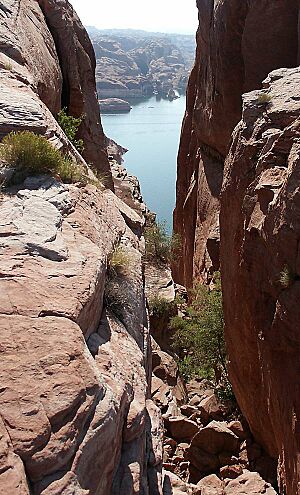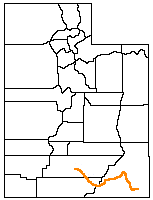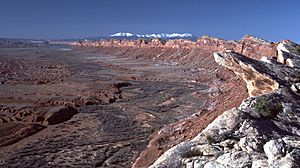San Juan Expedition facts for kids
The San Juan Expedition was a journey made by a group of Mormon settlers. They wanted to start a new town in what is now southeastern Utah, in the western United States. Their trip through the tough canyons of the Colorado River showed how clever and determined people were during the time of western exploration and settlement in the country.
Why the Journey Started
After arriving in the Salt Lake Valley in 1847, the Mormon settlers had built many towns. These towns spread across central and southeastern Utah. In 1878, their church leaders decided to start a new settlement. This new town would be in a faraway area east of the Colorado River. This area is now known as the Four Corners region.
They chose Silas S. Smith and Jens Nielson as some of the leaders for this journey. They looked for good places to settle. They picked the rich valley of Montezuma Creek, just north of the San Juan River. They also looked for ways to get to this new town. They thought about using the well-known Old Spanish Trail. Another idea was a very long route around the southern edge of the Grand Canyon.
However, the expedition decided on a shorter, more direct path. This route was mostly unknown. It would save hundreds of miles. Their plan was to travel through the easier land near the Escalante River. Then, they would find a way to cross the Colorado River. After that, they would have to get through the mountains and canyons on the other side.
The Big Adventure Begins

In the fall of 1879, people who volunteered for the journey gathered their wagons, supplies, and animals. They met at a spring at the start of Fortymile Gulch. This spot was just south of the deep canyons of the Escalante River Basin. It was also just north of the cliffs of the Kaiparowits Plateau.
A smaller group went ahead to find and prepare a way to cross Glen Canyon and the Colorado River. At Cottonwood Canyon, they saw a good path going up from the far side of the river. On their side, they found a narrow crack in the rock. This crack might let them go down into the canyon. They named it Hole-in-the-Rock. They spent several months making it wider for wagons. They also built anchor points and tracks to help with the steep climb down.
The main group followed what is now the Hole in the Rock Trail. On January 26, 1880, they began their descent to the river. People and animals carefully climbed down the crack. Wagons went down with their brakes locked. As many as 10 to 20 men held ropes to slow the wagons down. Near the bottom, a wooden track helped them get around a rocky ditch. Charles Hall built a wooden ferry at the river, which they used to cross. Even though this path was very dangerous, everyone in the expedition made it down. A third of the descent happened on the first day!
Kumen Jones, a member of the expedition, wrote about the experience:
After about six weeks work and waiting for powder, etc., a start was made to move the wagons down the hole. I had a well broken team and hitched it on to B. Perkins wagon and drove it down through the hole. Long ropes were provided and about 20 men and boys held on to the wagons to make sure that there would be no accidents, through [brakes] giving way, or horses cutting up after their long lay off, but all went smooth and safe, and by the 28th, most of the wagons were across the river and work had commenced again on the Cottonwood Canyon another very rough proposition.
The Journey Continues
However, the expedition faced even greater challenges on the east side of the river. This area was a confusing maze of canyons, mountains, and cliffs. It stretched from the Colorado and San Juan Rivers, making it almost impossible to pass. They had to go completely around the deep canyons of Grand Gulch. This forced the expedition far to the north.
Finally, they reached Salvation Knoll, on top of Cedar Mesa. This spot was near where Natural Bridges National Monument is today. From there, they could see an easier slope. This slope would lead them down into Comb Wash. Through Comb Wash, they could travel back south to the San Juan River.
After traveling further east, they were only twenty miles from their first goal. The tired expedition stopped in April 1880. They founded the community of Bluff there.
A journey that was supposed to take six weeks had instead taken six months. Amazingly, no lives were lost during the trip. Three children were even born along the way! The expedition's route was used as a supply road for only about a year. Then, Charles Hall moved his ferry to an easier crossing further north. This new crossing had simpler routes on both sides of the river.
In Popular Culture
The movie Wagon Master from 1950 was directed by John Ford. It is loosely based on the San Juan Expedition.
The book The Undaunted is a historical novel by Gerald N. Lund. It tells the story of the expedition. The author used diaries and other accounts to write it. The story focuses on one made-up family among the real people on the trip, including Jens Nielson.



